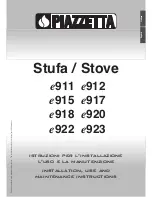
UK/IRL
UK/IRL 39
10.2 To light
1. Push in and turn the control knob (A) from
anticlockwise to the setting
(small
flame). You will hear an ignition click. Check that the pilot is lit (if not repeat).
2. Continue to hold in the control knob for a further ten seconds to ensure that the
pilot flame is stable.
3. Release the knob. The pilot should remain alight.
4. Turn the control knob A to the
position.
5. Turn knob B slowly anticlockwise, the fire should then ignite.
6. Adjust flames to the required level.
10.3 To extinguish
1. For the main burner turn the control knob B clockwise to position
.
2. To enable knob B turn knob A to the position.
3. To extinguish the pilot turn control knob A to position
, although it is in order to
leave the pilot permanently lit.
UK/IRL
UK/IRL 40
10.3.1 When the pilot extinguishes
Warning!
When the pilot extinguishes, for whatever reason, you should wait at least
5 minutes before trying to turn it on again.
Possible causes of pilot extinguish are:
-
Operating error.
-
Interference of the safety device.
-
Failure in the pilot flame system.
Contact a qualified installer when the appliance goes off regularly
.
10.4 Remote control version
The remote control is only meant to regulate the flames from off till max., it functions
only when the pilot burner is ignited and knob A in
(big flame) position. It is
therefore not possible to ignite the pilot flame with the remote control or to extinguish
the pilot flame. The radio-frequency remote control is intended for fireplaces installed
in a domestic setting in all EU countries, except Austria, Denmark, Finland and
Greece.
Features:
-
Manual control will always remain possible.
-
The remote control is a radio frequency type and had been approved internationally.
-
The remote control generates a unique safety code every time you activate the
transmitter, it's similar to those used in a car
.
-
The remote control is easy to install retrospectively
.
Summary of Contents for TIMRA
Page 2: ......




































